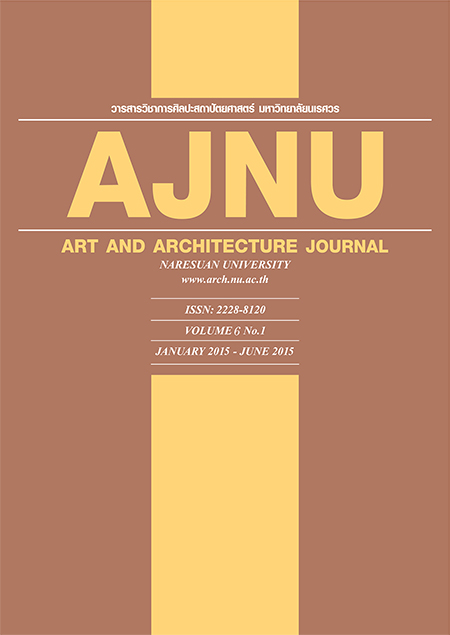การศึกษาเปรียบเทียบพัฒนาการของวิหารไทลื้อ ระหว่างกรณีศึกษาในเมืองน่าน ประเทศไทย กับกรณีศึกษา ในแคว้นสิบสองปันนา มณฑลยูนนาน สาธารณรัฐประชาชนจีน The Comparative Study of Development of Dai-Lue Vihara in Nan,Thailand and Xixuangbanna, Yunnan, China
Main Article Content
Abstract
การศึกษาเปรียบเทียบพัฒนาการของวิหารไทลื้อในสิบสองปันนา และในจังหวัดน่าน ประเทศไทย มีจุดมุ่งหมายที่จะ
ศึกษาถึงรูปแบบของวิหารไทลื้อที่มีเอกลักษณ์เฉพาะตัวและมีการปรับเปลี่ยนโดยได้รับอิทธิพลที่แตกต่างกัน ส่งผลต่อรูปแบบของ
วิหารไทลื้อทั้ง 2 แหล่งที่ตั้งจากกรณีศึกษานำมาสู่การวิเคราะห์ในแง่มุมต่างๆ อันได้แก่ แผนผังวัด แผนผังอาคาร รูปแบบทาง
สถาปัตยกรรม และลักษณะโครงสร้างทางสถาปัตยกรรม จากกรณีศึกษาทั้ง 7 หลัง ผลของการศึกษาทำให้ทราบว่า ในดินแดนสิบ
สองปันนา รูปแบบการสร้างวิหารก็ยังยึดถือรูปแบบเดิม แต่ใช่ว่าเป็นรูปแบบเดิมทั้งหมด ยังมีบางส่วนได้รับอิทธิพลจากศิลปะ
สถาปัตยกรรมจีนเข้ามาผสมด้วย ส่วนในประเทศไทย ในช่วงที่มีการตั้งถิ่นฐานของชาวไทลื้อ ในบริเวณภาคเหนือของประเทศไทย
รูปแบบของวิหารในช่วงแรก เป็นรูปแบบที่มีลักษณะใกล้เคียงกับรูปแบบเดิมจากวิหารต้นแบบที่สิบสองปันนา หลังจากนั้นตลอด
ระยะเวลาที่ผ่านมา ยังได้รับอิทธิพลจากวัฒนธรรมล้านนาและประเทศใกล้เคียง เช่นรูปแบบของวิหารทรงคฤห์ที่ได้รับอิทธิพลของ
วิหารแบบล้านนา หรือ วิหารที่มีหลังคาอ่อนช้อยแบบหลวงพระบาง ทำให้รูปแบบของวิหารไทลื้อมีการเปลี่ยนแปลงไปตามลักษณะ
ของกลุ่มชน และผู้คนที่ให้การอุปถัมภ์ แต่อย่างไรก็ตาม รูปแบบวิหารไทลื้อที่พบจากทั้งสองแหล่งที่ตั้งของกรณีศึกษาก็ยังมี
ลักษณะร่วม กล่าวคือ การคงไว้ซึ่งแนวคิดของวิหารไทลื้อต้นแบบที่สิบสองปันนา ผสมผสานกับความเป็นท้องถิ่น จนทำให้เกิดวิหาร
ที่มีลักษณะเฉพาะตามถิ่นที่อยู่นั้นขึ้นมา
A comparative study on Viharas of Dai-Lue in Sib Song Punna, China; and in Nan, Thailand aims to
explore the unique identity of Vihara Dai Lue and their transformation due to different influence and
different locations. Seven Viharas were selected as case studies in order to analyse temples' lay outs, Viharas'
floor plans, architectural characteristics and structures. Findings from the study reveal that almost all of
Viharas in Sib Song Panna had been built regarding with traditional ways; whereas some Viharas had been
partially influenced by Chinese art and architectural styles. During the early settlements of Dai-Lue
settlement in the North of Thailand, the study shows that the characters of Viharas remains similar to Sib
Song Panna’s traditional style as a Vihara with Hipped roof and Gable on the Top .Since then the
characteristics of Viharas has been transformed in line with Lanna culture and other adjacent cultural
influence. Vihara Karu (Vihara wita gable roof, as Lanna style)style is a case in point of Lanna identities, and
Viharas with the roof light cave is an illustration of Luangprabang styles. This study points out that
transformation of Vihara Tai Lue were created in regard to the main characteristics of any supportive groups.
Interestingly, Vihara Tai Lue in both study areas has something in common; they were built in line with Sip
Song Punna characteristics; and they were mixed and engaged with the local cultural styles. These two
factors make Viharas of Tai Lue has become unique and different from other.


